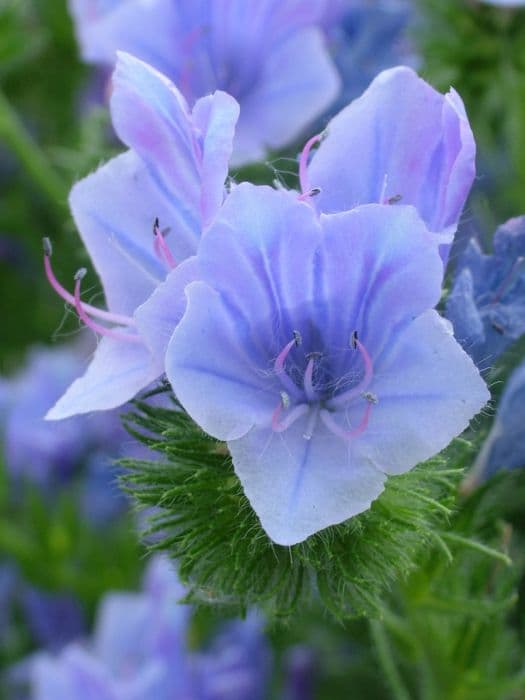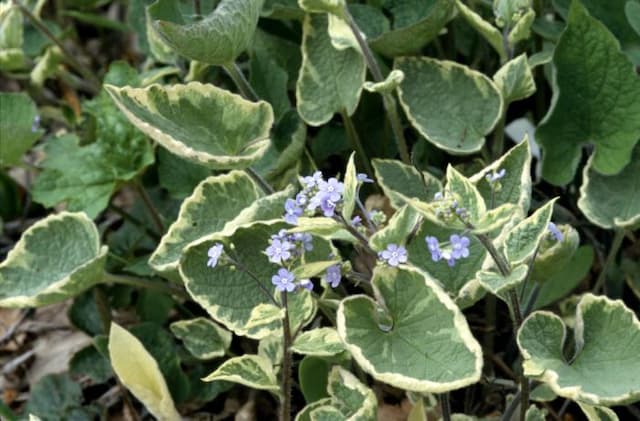Viper's Bugloss Echium vulgare 'Blue Bedder'

ABOUT
The 'Blue Bedder' variety of Viper's Bugloss is an eye-catching flowering plant known for its prominent inflorescences. This plant has rough, hairy lance-shaped leaves that sprawl out from a central stem, providing a lush green backdrop for the blossoms. The flowers, arranged in a dense, cylindrical shape, are what primarily capture the observer's attention. They boast a vibrant shade of blue, sometimes with purple or pinkish hues, making them stand out in the plant world. The bloom clusters are often likened to spikes or rat-tails due to their long, narrow shape. Each flower is tube-shaped, flaring out into five petite petals at the end. The petals may sometimes display more vividly colored or white throats. Adding further intrigue to the flowers, protruding stamens give the blooms a whiskery appearance, contributing to an overall borage-like allure. These striking features entice a variety of pollinators, making the Viper's Bugloss 'Blue Bedder' not just visually appealing but also beneficial for garden ecology.
About this plant
 Names
NamesFamily
Boraginaceae.
Synonyms
Viper's Bugloss, Blueweed, Blue Thistle, Snake Flower, Blue Devil.
Common names
Echium plantagineum, Echium angustifolium.
 Toxicity
ToxicityTo humans
Viper's Bugloss, the common name of Echium vulgare 'Blue Bedder', is considered to have a certain degree of toxicity to humans if ingested. It contains pyrrolizidine alkaloids, which can be toxic to the liver and pose risks if consumed in large quantities. Symptoms of poisoning by plants containing these alkaloids may include gastrointestinal upset, such as nausea, vomiting, and diarrhea. Chronic exposure or significant ingestion can lead to more severe conditions such as liver damage, although casual contact or minor ingestion usually does not result in severe toxicity.
To pets
Viper's Bugloss, the common name of Echium vulgare 'Blue Bedder', can also be toxic to pets if ingested, due to the presence of pyrrolizidine alkaloids. These compounds can cause liver damage over time with chronic exposure or if consumed in large amounts. Signs of poisoning in pets may include vomiting, diarrhea, and lethargy. With extended ingestion, more serious conditions such as liver failure can occur. Pet owners should prevent their animals from consuming Viper's Bugloss to avoid potential health issues.
 Characteristics
CharacteristicsLife cycle
Biennials
Foliage type
Deciduous
Color of leaves
Green
Flower color
Blue
Height
2 feet (60 cm)
Spread
1 foot (30 cm)
Plant type
Herb
Hardiness zones
3
Native area
Europe
Benefits
 General Benefits
General Benefits- Attracts Pollinators: Echium vulgare 'Blue Bedder' is known for its ability to attract bees and other pollinators, which is essential for the pollination of crops and other plants.
- Drought Tolerance: Once established, Viper's Bugloss has a good level of drought tolerance, making it suitable for dry or xeriscaped gardens.
- Low Maintenance: This plant requires minimal care once established, needing infrequent watering and no complicated pruning.
- Aesthetic Appeal: Echium vulgare 'Blue Bedder' has bright blue flowers that provide a beautiful display of color in the garden.
- Wildlife Habitat: The plant offers shelter and food to wildlife, especially beneficial insects and birds.
- Adaptable: Viper's Bugloss is adaptable to a variety of soil types, though it prefers well-drained soil.
- Fast Growth: The plant is known for its rapid growth, quickly filling in garden spaces and providing a lush appearance.
- Easy Propagation: It can be easily propagated from seed, allowing gardeners to produce new plants economically.
 Medical Properties
Medical Properties- Anti-inflammatory: Echium vulgare, commonly known as Blue Bedder or Viper's Bugloss, contains constituents like gamma-linolenic acid which may have anti-inflammatory effects.
- Demulcent: The plant's mucilage content can be soothing to mucous membranes and may be used for conditions such as irritation or inflammation of the throat.
- Expectorant: It has been traditionally utilized to ease coughs and could act as an expectorant to help in the clearance of mucus from the respiratory tract.
- Vulnerary: Contains compounds that might promote the healing of wounds when applied topically.
 Air-purifying Qualities
Air-purifying QualitiesThis plant is not specifically known for air purifying qualities.
 Other Uses
Other Uses- Echium vulgare 'Blue Bedder', commonly known as Viper's Bugloss, can be used as a natural dye, producing colors ranging from blue to purple when used in fabric dyeing processes.
- Its rough leaves have been historically used as a natural abrasive for cleaning pots or smoothing wooden surfaces.
- Young leaves of Viper's Bugloss can be eaten in moderation when cooked, sometimes added to dishes as a potherb.
- The plant provides a high nectar output which makes it valuable for honey production, yielding a lightly colored and delicately flavored honey.
- The spiky structure of the drying plant can be incorporated into floral arrangements for a unique texture.
- Viper's Bugloss often finds its use in educational settings as an example of coevolution due to its specialized flower structure that fits certain pollinators.
- The seeds of Viper's Bugloss are a potential source of gamma-linolenic acid (GLA), which is an essential fatty acid used in various nutritional supplements.
- The plant can act as a natural indicator of soil conditions, often growing in places with high soil compaction or poor quality, helping assess the need for land management or restoration.
- Traditionally, Viper's Bugloss stalks have been used to make a rough cordage or plant ties in the garden due to their fibrous nature.
- Artists have been known to use the striking blue flowers of Viper's Bugloss as subjects or inspiration in botanical illustration and naturalistic paintings.
Interesting Facts
 Feng Shui
Feng ShuiThe plant Viper's Bugloss is not used in Feng Shui practice.
 Zodiac Sign Compitability
Zodiac Sign CompitabilityThe plant Viper's Bugloss is not used in astrology practice.
 Plant Symbolism
Plant Symbolism- Pride: The towering spires of intense blue flowers of Echium vulgare, commonly known as Viper's Bugloss, are often associated with pride due to their lofty and proud appearance.
- Attraction: It is believed that the bright and vibrant flowers of Viper's Bugloss symbolize attraction, drawing in onlookers and pollinators alike with their brilliant display.
- Nature’s power: The hardy and resilient nature of Viper's Bugloss allows it to thrive in rough, challenging environments, symbolizing the power and adaptability of nature.
 Water
WaterViper's Bugloss prefers a well-draining soil and does not like to be overwatered. Water the plant deeply once the soil feels dry to the touch, approximately every 1 to 2 weeks, depending on climate conditions. It typically requires about 1-2 gallons of water per month during the growing season, with reduced watering in the winter months. Care should be taken to water the base of the plant rather than the foliage to minimize the risk of disease. Avoid waterlogging as this can lead to root rot.
 Light
LightViper's Bugloss flourishes in full sun and will perform best when it receives at least 6 hours of direct sunlight per day. An optimal spot would be in an area with unobstructed access to sunlight, such as a south or west-facing garden bed. This plant is tolerant to partial shade but may not bloom as prolifically.
 Temperature
TemperatureViper's Bugloss is hardy and can tolerate temperatures as low as 20°F and as high as 90°F. However, its ideal growing temperature is between 60°F and 75°F. It can survive in cooler temperatures but may require protection from frost.
 Pruning
PruningPruning Viper's Bugloss is mainly for shaping purposes and removal of spent flower spikes to encourage more blooms. It's best to prune or deadhead after the first flush of flowers to promote a second bloom period. Pruning can be done every few weeks during the blooming season, which is typically late spring through summer.
 Cleaning
CleaningAs needed
 Soil
SoilViper's Bugloss, or Blue Bedder, thrives best in a well-draining soil mix with a pH ranging from neutral to slightly alkaline (pH 7.0-8.0). A blend of garden soil, sand, and compost will promote healthy growth. Ensure good drainage to prevent root rot.
 Repotting
RepottingBlue Bedder, commonly known as Viper's Bugloss, does not generally require frequent repotting as it is a short-lived perennial or biennial. Repot every 2-3 years or as necessary to refresh the soil.
 Humidity & Misting
Humidity & MistingViper's Bugloss, or Blue Bedder, is adaptable to a wide range of humidity conditions and does not require high humidity levels to thrive. Average room humidity is generally sufficient.
 Suitable locations
Suitable locationsIndoor
Place Viper's Bugloss in a sunny spot with well-draining soil.
Outdoor
Grow Viper's Bugloss in full sun and well-draining soil.
Hardiness zone
3-8 USDA
 Life cycle
Life cycleEchium vulgare, commonly known as Viper's Bugloss or Blueweed, begins its life cycle as a seed, which upon germination in early spring gives rise to a rosette of hairy, lance-shaped leaves. This basal rosette overwinters and, in the following spring or early summer, elongates into a flowering stem that can reach up to 30 inches in height, bearing clusters of blue or violet flowers that are very attractive to pollinators. After pollination, typically by bees, the flowers develop into nutlet fruits, each containing seeds that are dispersed by wind or animal activity. These seeds enter a period of dormancy and will germinate when conditions are favorable again, typically needing a period of cold to break dormancy. The plant completes its life cycle in two years, behaving as a biennial; it grows vegetatively in the first year and flowers, fruits, and dies in the second year. At the end of its life cycle, the dead plant may leave behind numerous seeds, which preserve its genetic lineage by initiating a new generation of plants.
 Propogation
PropogationPropogation time
Spring to Summer
Echium vulgare 'Blue Bedder', commonly known as Viper's Bugloss, is easily propagated by seed. The best time to sow the seeds is either in fall, allowing for a natural stratification process over the winter, or in early spring after the last frost when the soil has started to warm up. The seeds should be sown directly into a well-draining soil medium, lightly covered with soil, and spaced adequately to avoid overcrowding. Consistent moisture should be maintained until germination, which typically occurs within two to three weeks. Once the seedlings have developed true leaves and are large enough to handle, they can be thinned out or transplanted to their final growing positions in the garden.









